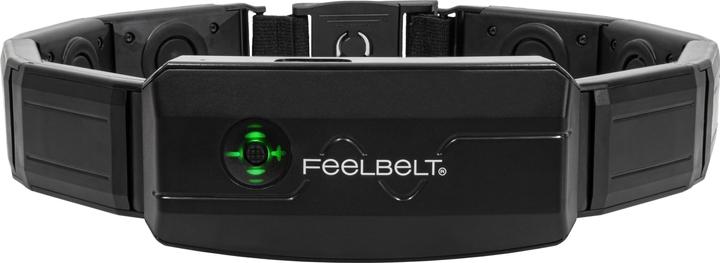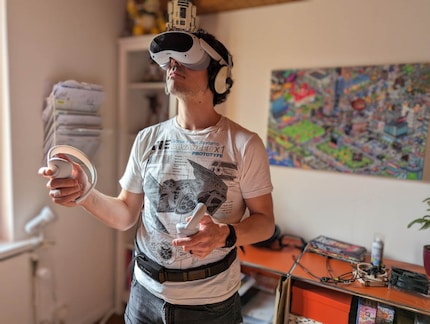

Testing the Feelbelt: pricey and impractical
The Feelbelt is a vibrating strap that helps you feel games or music. But what I’m feeling most is complete bemusement over who would actually buy something this inconvenient and expensive.
I’ve tried out many a wondersome device. The Cyborg controller, Nintendo fitness ring or the OJO portable projector, for example. But never before have I come across anything that takes itself so seriously yet manages to be completely impractical.
Shell out 275 francs and you’ll get a belt that converts stereo sound into vibrations in return. Ten so-called pulse generators give you haptic feedback. Similar to what most game controllers do, but for your belly instead. You wear the Feelbelt like a regular belt. For best results, you should wear it just above your waist. My version is a size 1 and will fit abdominal girths between 72 and 110 centimetres.

Not exactly plug-and-play
The Feelbelt has a single button you can move in four directions like a joystick. It’s for adjusting both the volume of connected headphones as well as the intensity of the vibrations. To switch the Feelbelt on, you press on the joystick. You can connect it via Bluetooth or with a 3.5 mm headphone cable. Bluetooth has the advantage that you’ll only need one cable at most. This is because your speakers or headphones will stop emanating sound as soon as you transmit sound to your Feelbelt via Bluetooth or a 3.5 mm connection. That’s why the Feelbelt features an extra 3.5 mm output for headphones. If you’re running low on battery, you can connect a third cable for charging via USB-C.

Source: Philipp Rüegg
In theory, you can use the Feelbelt with no cables at all. In this case, the sound is transmitted to the Feelbelt via Bluetooth and then sent to your headphones via Bluetooth, too. To make use of this, your device must be able to handle two simultaneous Bluetooth connections. A PC can usually manage this. However, you will need additional software such as VoiceMeeter to control the input and output properly. Many smartphones can also manage two Bluetooth connections at the same time. In other words, you connect your Bluetooth headphones and the Feelbelt simultaneously. Sound overly complicated? That’s because it is. It’s not exactly plug-and-play.
When I used it with my PC, I mostly used the included jack cable to hook up the Feelbelt to my headphone amp. The cable’s only one metre long. To connect it, I need an adapter for the 6.35 mm jack plug. None of my adapters are a great fit for the Feelbelt’s jack cable. And so, it’s quite loose after I hook it up, which makes the shortness of the cable even more problematic. I then connect my headphones to the Feelbelt. I can only shake my head at this setup. Never ever would I put up with this kind of cable clutter if it weren’t for this review.
It’s easier to use a Bluetooth controller such as Dual Sense, which can transmit audio signals. Simply select the controller as output on the PC or console. I then connect the headphones to the controller. If I’m using my mouse and keyboard to play, the controller is idly sitting on my desk. Turns out not as idly as I’d hoped. Every time it vibrates, my whole desk buzzes. Pretty annoying.

Source: Philipp Rüegg
Things aren’t exactly straightforward with a VR headset either. Neither the Meta Quest 2, nor the Quest Pro nor the Pico 4 can handle two Bluetooth connections. This means your headphones have to be connected by way of a cable. This proves particularly annoying as all three headsets have built-in speakers, which can’t be used in combination with the Feelbelt. If there’s one thing I want to avoid in VR, it’s cables. Although they don’t present trip hazards in this case, they do unnecessarily complicate the already rather tiring VR experience.
Irritating buzzing, occasional laugh
But what does the Feelbelt feel like, I hear you ask. Not half bad! For one, it’s easy to put on. The wee latch clicks into place with ease and comes undone just as well. In the smartphone app, there are a total of four profiles: music, gaming, silent and bass. I can’t make out any significant differences between them. With some, there’s a bit more vibrating than with others. It seems that the profiles cover different frequencies. You can regulate the intensity independently of the profiles. The vibrations aren’t particularly complex and feel more like buzzing.
While playing the VR game Half-Life Alyx, the Feelbelt is vibrating pretty much nonstop. No matter what setting I’ve gone for. This is probably because the game often features a subtle rumble in the background. Having said that, in battles with Combine Soldiers, it’s quite fun to feel the vibration when shots are fired or when a grenade explodes. The buzzing even comes in from the right direction. However, this isn’t massive added value compared to a vibrating controller. Sure, the belt vibrates much more often, as it reacts to acoustic signals as opposed to pre-programmed ones controllers rely on. But at the end of the day, it just vibrates more often. Practically all the time, to be precise. And this can be quite annoying. It’s not subtle like the vibrating triggers of an Xbox controller, let alone on the level of a Dual Sense. That’s in a league of its own.

Source: Image: Philipp Rüegg
But the Feelbelt definitely offers added value. For example, in a racing game like Need for Speed Unbound. As I race along at 160 mph, I feel a rumble in my belly. This makes my driving experience more lively overall. Or in Wild Hearts, when I fail to dodge the attack of a humungous monster and am hurled through the air. Feelbelt immediately lets me know I’ve not played too well.
My best experience so far was with Doom, as in the original from 1993. The vibrations perfectly complement the wicked soundtrack. Particularly when I’m reducing demons to a pulp with a massive shotgun, I can feel the oomph.
Speaking of music. While the vibrations enhance the action and the soundtrack in Doom, the Feelbelt bothers me when I’m just listening to music. To me, it’s a passive experience that doesn’t have me craving a belly massage. Depending on the style of music I’m listening to, it can also feel as if my stomach’s rumbling. Take rock music by «The Hellacopters», for example. The vibration feels like when you stand too close to the speakers at a concert. I’m sure some people will enjoy this, but for me, the time has come to give up on the belt.

Source: Photo: Philipp Rüegg
A costly dust catcher
Everyone I’ve told about the Feelbelt so far has reacted the same way. A puzzled frown followed by a sceptical, «Is it any good?». My reply’s been «Yeah, it has it moments.» That pretty much sums up the Feelbelt. It’s the type of gadget you’ll use a few times, show your friends and then leave to gather dust. It’s not very good for listening to music, where the vibrating doesn’t offer much added value. I see it primarily as an extension for games. Feeling the on-screen action reverberate in your body is certainly fun – for a short time at least.
I reckon the best place for the Feelbelt would be in a VR centre. There, it wouldn’t really matter if you had to strap on a belt on top of the rucksack. Since I finished testing it, I haven’t touched the Feelbelt again. Why? Because the setup via Bluetooth and cable’s a pain, and I find the belt too heavy to wear over a long period of time. What’s more, the vibration is just a nice feature. No more, no less. Yes, it has it moments. But is that worth 275 francs?
As a child, I wasn't allowed to have any consoles. It was only with the arrival of the family's 486 PC that the magical world of gaming opened up to me. Today, I'm overcompensating accordingly. Only a lack of time and money prevents me from trying out every game there is and decorating my shelf with rare retro consoles.


